What Type of Update Does Not Allow a User to Refuse or Delay Security Updates?
We are reader supported and may receive a commission when you make purchases using the links on our site.
Software and security updates: Why they're important and where to find them
Software updates might be annoying just they are there for a very skillful reason.
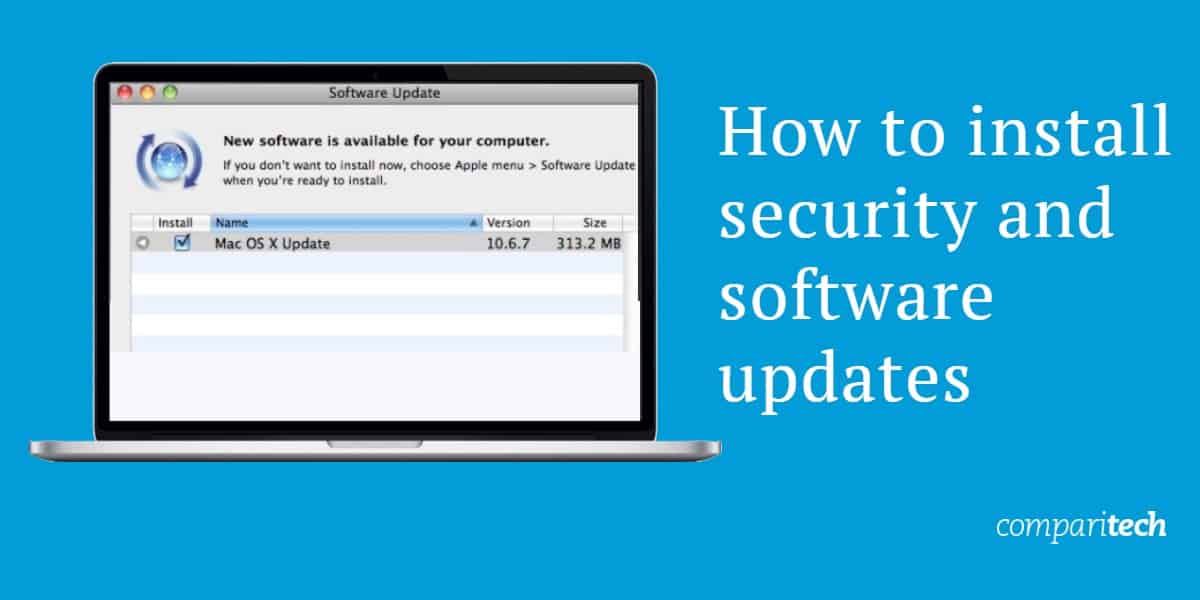
At some indicate in time, if you've used a computer or a piece of software long enough, yous've probably seen several messages pop upwardly request you to install security updates. Far likewise often, many consumers ignore these critical security updates pushed out either by application developers or operating system companies like Microsoft or Apple tree. Finding information on security updates, including how to properly install them, can also exist fourth dimension-consuming. To aid readers relieve time, we've gathered information on how to manage updates on all major computer and mobile operating system, equally well as a scattering of important, integrated applications.
It's understandable why you might try to ignore these updates, peculiarly for your operating system. On occasion, they require you to finish what y'all're doing on your computer and can cause significant piece of work disruptions as your computer is unusable for xv, twenty, or even xxx minutes at a fourth dimension (or more, depending on how many updates you've ignored). For enterprises, especially, this kind of piece of work disruption on a large calibration is extremely expensive, even when the update is free.
Nonetheless, those security updates that software companies push out to you lot are not inconsequential. What's happening is that these companies, through one means or another, are locating security flaws in their software that could let hackers to compromise the software or even your entire reckoner arrangement using malware or other means. Ultimately, they may steal your information, destroy your information, or completely shut down the affected program or operating system. Security updates may feel similar a hassle, but they're usually here to help keep your computer more secure.
How to install security updates and software updates for operating systems
Unfortunately, there's no "ane style" to perform security updates. How a software developer chooses to make updates available will change, depending on which programmer or company fabricated the software. Nevertheless, there are some ways to assistance cover a larger number of applications and operating systems quickly, including assuasive many applications to automatically install those updates for you lot.
Windows Security and Software Updates
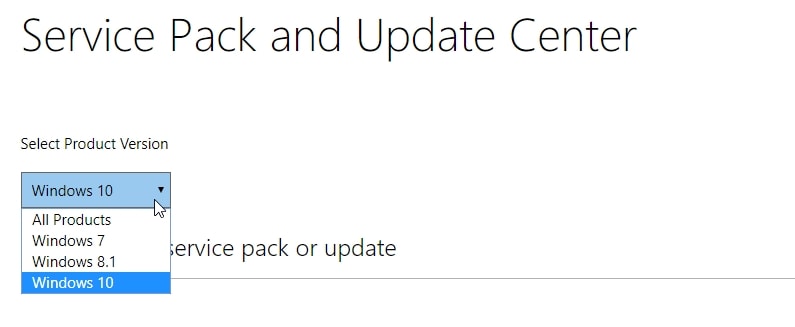
Service Packs
Microsoft rolls out updates to their operating systems using a few methods. One known method the company uses is through what they phone call Service Packs. The company explains that a Service Pack " is a Windows update, often combining previously released updates, that helps brand Windows more reliable."
The "reliability" Microsoft mentions here is quite often the patching of security flaws, although a Service Pack will contain a large number of dissimilar fixes for issues across just security problems.
You tin can download Service Packs for Windows manually or automatically through your operating system settings. The procedure for this will exist slightly different, depending on which version of the Windows operating system you're using.
Proceed in listen that Service Packs are not delivered on a regular basis, and many of Microsoft'due south operating systems only receive one or 2 Service Packs during their support cycle. Do not rely on Service Packs to receive regular security updates.
To manually install Microsoft Service Packs, do the following:
- Get to the Microsoft Download Center
- Type in "Windows [insert Bone number] service packs" (for case, Windows vii)
- Locate the newest Service Pack for your operating system
- Click to download the Service Pack for your specific operating system.
To automatically install Microsoft Service Packs and other updates, do the post-obit:
Windows x: All Windows Updates in Windows 10 are automated. They cannot be turned off.
However, Microsoft now allows you to ignore them or filibuster them if you wish, just yous tin can't completely shut them off. Once you restart your computer, you'll be forced to install the update. You tin likewise check for new updates manually earlier they go active on the schedule by using this method:
- Click on the Windows button on the left and open Settings
- Click on Update and Security
- Go to Windows Update
- Click on Check for Updates
Windows viii.1: You lot can plough automatic updates on in Windows 8.ane by doing the following:
- Point your mouse to the lower-left corner of your screen and motion information technology upward to open up the Settings menu
- Select Change PC Settings
- Click on Update and Recovery
- Click on Windows Update . Yous tin bank check for updates manually hither by clicking on Bank check At present
- Click on Choose How Updates Become Installed
- Under the Important Updates section, enable Install Updates Automatically
- Under Recommended Updates , select the box for Give Me Recommended Updates The Aforementioned Way I Receive Important Updates
- Nether Microsoft Update , select the box for Requite Me Updates for Other Microsoft Products When I Update Windows and then select Apply.
Windows vii: You can plow on automated updates in Windows 7 by doing the following:
- Click on the Start push
- When you see the search box, type in Update . You volition receive a list of results, from which you should select Windows Update
- On the left, click on Change Settings . Under Of import Updates , select Install updates automatically
- Finally, under Recommended Updates , select Give Me Recommended Updates the Same Way I Receive Important Updates and click OK
Transmission security-specific updates
To manually install Windows security-specific updates, click here to go to Microsoft'southward Security TechCenter. You lot'll find a list of recent security updates Microsoft has pushed out, organized past appointment. You can search for security updates for your specific arrangement by clicking on the right-hand search box and typing in the appropriate operating system.
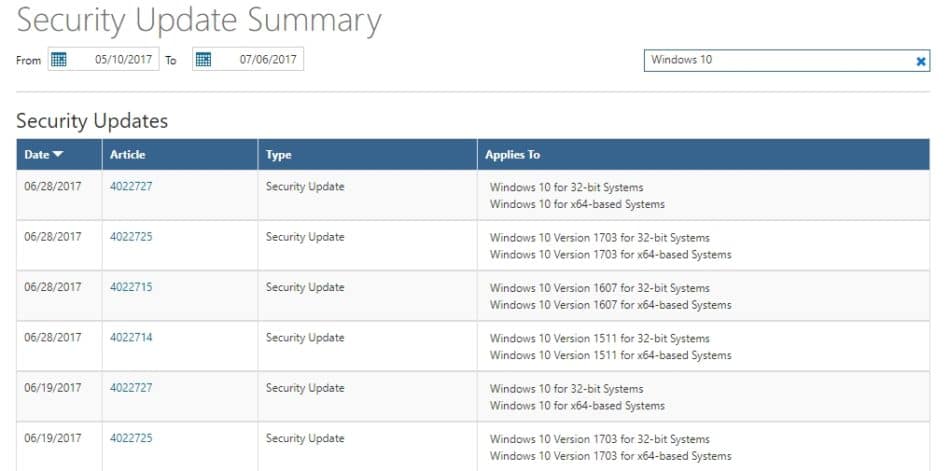
Automatic updates for Windows Shop apps
Windows 10 and eight.1 users tin can choose to have apps automatically update if they were installed through the Windows Shop.
For Windows 10, do the following:
- From your Beginning screen, click on the Store icon to open up the Windows Store
- Click on the Account Carte (usually your personal Windows icon or motion-picture show beside the search box) and click on Settings
- Wait nether App Updates and enable the Update Apps Automatically pick
For Windows viii.i, do the post-obit:
- Locate and click on the Store icon from the Beginning screen to open up up the Windows Store
- Swipe right from the right edge of the screen and tap Settings , or if using a mouse, point to the lower-correct corner of the screen and motion the pointer up
- Select App Updates
- Make sure Automatically Update My Apps is set to Yes
Install the latest version of Windows
If you're currently using an older version of Windows, it may be wise to update to the latest version. Microsoft offered a free upgrade from Windows 7 or 8 to Windows x upwardly to July 29, 2016. Those looking to upgrade nowwill not go the complimentary upgrade option.
Y'all tin purchase and download the either the full version of Microsoft Windows 10 or by purchasing a device that has Windows 10 already installed.
If you lot accept Windows 8, an easy method to upgrade to Windows x is by going to the Windows Shop and typing inWindows 10 to become an upgrade pick. Windows 7 may be able to install this upgrade through the Microsoft update notifications.
Note: ZDNet suggests that you may yet exist able to receive a free Windows ten upgrade. Click here to read more.
Mac OS and app security and software updates
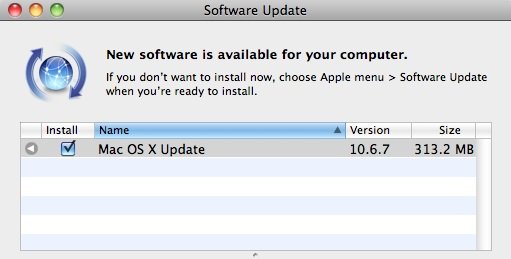
Every bit with Windows, Mac users tin can adjust some of their security and software update settings. Apple tree makes this process a fleck simpler than Windows, however. You lot tin set your Mac to automatically install updates to your operating arrangement and any applications you downloaded through the App Shop, or simply go app by app and download those updates yourself. If y'all don't have the App Store installed on your Mac, you can still check for OS security updates from your system settings.
You tin merely update any apps on your organization using the Apple ID that was used to purchase the app.
To manually install updates on your Mac from your App Store, do the post-obit:
- First, bank check your App Store icon. It will indicate a number on the side of the icon that represents the number of updates currently available for download
- Open your App Shop
- Click on Updates
- Individually click on whatever apps yous desire to update, or click on Update All
When updating Mac Bone Ten specifically, you tin click the More than link for the update and come across if there are updates for specific Mac applications and components, such as Safari or iTunes.
Even so, Apple tree installs required security updates automatically . If yous want to turn off automatic security updates, practice the post-obit:
- Click on the Apple menu and and then go to Organisation Preferences
- Click on App Store and then deselect the Install System Information Files and Security Updates option.
- You lot may likewise want to deselect the Automatically Check for Updates choice and the Download Newly Available Updates in the Groundwork pick to completely disable all aspects of automatic updates
Please notation, disabling automatic security updates is not recommended.
Additionally, the post-obit issues may be relevant to your update process:
- If you lot're using a personal hotspot, big automatic downloads are disabled
- If you're using a business or school network, you lot may non have access to Apple'south software update servers, in which example you may need to install the updates manually
Don't see an update you expected? Try this:
- Later on installing any available updates, look to see if you still accept whatsoever updates bachelor. At times, some updates merely appear after you've already installed other updates
- Click on the Search box and type in the app name you lot want to update to encounter if it was missed
- Select the Purchased selection and check to see which apps you lot already purchased. There's a run a risk you may be on the wrong Apple ID, or that you downloaded the app from a location other than the App Store
- Os 10 Snow Leopard and Bone X Lion users tin find updates to the operating arrangement by going to Software Update from the Apple tree menu, and app updates from the Mac App Store
Android OS and app security and software updates
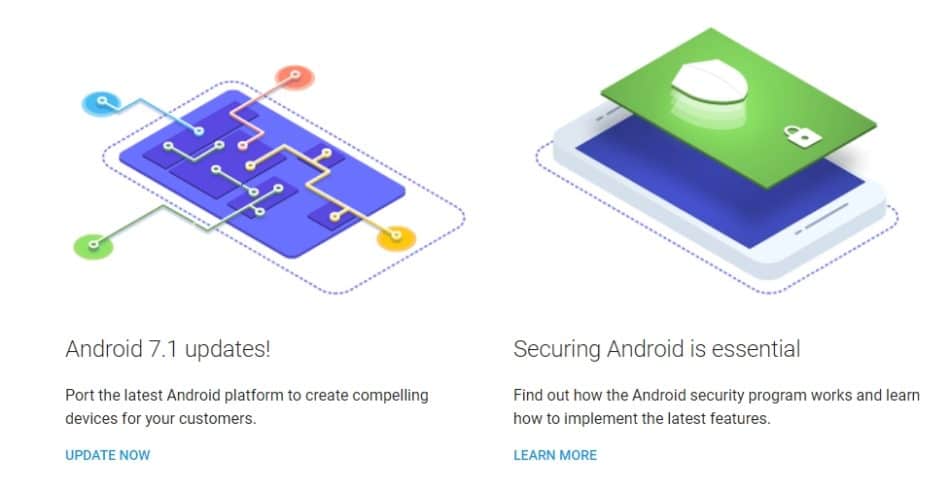
Android users can turn app updates on or off through the Google Play Store settings. However, you lot cannot gear up the operating organization to automatically install software updates. Android volition push out notifications when an update is gear up for the operating system.
You can too cheque for updates manually. If your device is not receiving updates, it may be because the device maker has chosen not deliver updates to your device.
Although Google makes system updates available, some device makers, such as Samsung and LG, simply provide the updates to newer devices. It is important to update Android when possible, every bit Android ranked at #1 on the CVE vulnerabilities list for 2016 and #6 for "All Time Leaders."
To adjust automatic updates for apps, practice the following:
- Open your Play Store app
- Tap on on the Menu icon (the 3 lines by the search bar)
- Tap on Settings
- Tap on Auto-update Apps
- Choose your desired update option, either Do Not Motorcar-Update Apps, Auto Update Apps at Any Time, or Auto-Update Apps Over Wi-Fi Just .
When apps are auto-updating, you'll see a download notification appear on the top of your screen.
To install or check for operating system and security updates, practice the following:
- Go to your device settings
- Locate and tap on About Phone
- Tap on Update Eye
- Tap on System Updates
- Hither, you will see the final time your Android device checked for updates. You lot tin also click on Check for Update at the bottom
Note: Android operating systems will vary in how the UI and settings menus are gear up up. Your menu layout for this process may expect unlike, depending on which mobile device you are using and which version of Android you have. However, this process should aid guide you to the right location for virtually Android versions for well-nigh mobile devices.
Additionally, note that if yous installed any Android apps from outside of Google Play, such as through a sideload or due to activating the Unknown Sources programmer pick, your apps volition not automatically update. You will need to update those apps manually by downloading the latest version to overwrite the current version on your device.
You can also determine how recently your security was patched nether Settings > General > About Phone > Software Info . Expect at the appointment nether Android Security Patch Level . If the date looks like information technology may be a fleck old, check with your device maker to come across if a patch is available. Google releases security bulletins monthly, and your device may or may not be among those receiving security updates.
How to install to latest Android version
Android is not an piece of cake operating organization to work with if you're trying to upgrade to a new version. Unfortunately, upgrading to a newer version is at times not possible. Whether you can or cannot upgrade to a new version depends on whether your phone provider decides to whorl out a new version for your phone model.
Outside of hoping your device maker and service provider offering a new version for your specific device, your only other choice is to install a newer version after rooting your telephone, which can be complex and may void your phone'southward warranty, alongside causing compatibility issues for your mobile device.
Apple tree iOS and mobile apps security and software updates
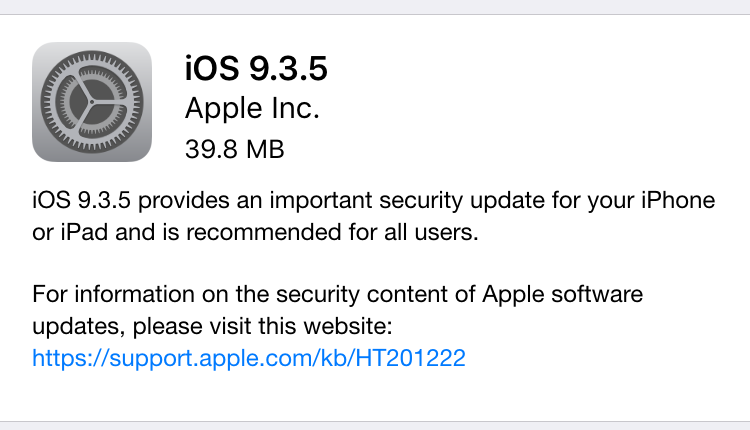
Apple makes it simple to update your iOS apps and software hands, either using a wireless connection or through a wired connection on a computer.
To update your iOS software, do the following:
- Make sure your device is continued to Wi-Fi with a working internet connection
- Tap on Settings
- Select Full general
- Get to Software Update
- You will see Download and Install . You may see a bulletin that iOS needs to temporarily delete apps. Either click Proceed or Cancel . Your apps will exist reinstalled after the installation process, and so it may be a good idea to hit Proceed if you're unsure
- Tap Install to showtime the process.
- If you want to delay the installation, choose Install Tonight or Remind Me Later on
To update your iOS apps, practise the following:
- Go to your Settings
- Tap [your name]
- Tap the iTunes & App Shop option
- Tap to turn on Updates if the option is off (grayed out bar)
To manually update any app, yous tin become to its page direct in the App Shop to check for updates.
Yous can likewise cheque out the Apple Security Updates folio to encounter if any of your devices have received recent updates.
How to install the latest iOS version
Installing the newest version of iOS follows the same process as with security updates.
To cheque for a new version on your iPhone or iPad, go to:=
- Settings
- Full general
- Software update
If you lot see a red number next to "Software update," it means there is an update available for your device. If you practise not see one, in that location is no update currently available. Click hither to bank check on the electric current version of iOS.
Linux security and software updates
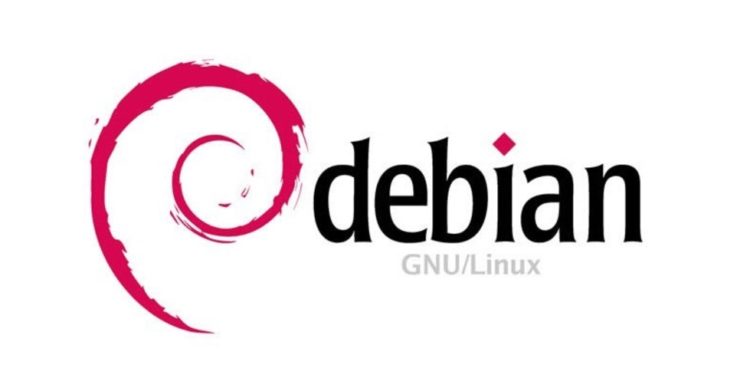
Linux is a bit more than complicated, as updating the system depends on which distribution you're using.
(This guide assumes you are a regular Linux user).
To install security updates on Debian, y'all'll need to use the following command:
$ sudo apt-become install unattended-upgrades Yous can too apply the following control to install security updates:
$ sudo unattended-upgrades To receive logs of the update process, use the post-obit command:
$ sudo unattended-upgrades -d To install security and software updates on Ubuntu, we recommend checking out this detailed guide .
Y'all can check for individual updates for Debian here.
You lot tin can cheque for individual updates for Ubuntu here.
How to install the latest Linux version (Debian and Ubuntu)
You can easily install a newer version of Linux direct on the distribution pages, or through the operating system.
Ubuntu users can update to the latest version using the Software Updater application. Click here for a how-to guide upgrading to the latest version of Ubuntu.
Considering Debian is a bit less user-friendly for newcomers, upgrading is a bit more difficult. Click hither to access a how-to from Debian on keeping the Bone updated.
Related mail service: Best Linux Patch Managers
Simulated security updates and how to avoid them
Not all security update warnings you receive are going to be existent. At times, you may see such messages and click on them, merely to notice cypher happens or that it opens a suspicious web page or tries to download a file blocked by your antivirus software or filters.
Given how common software security updates really are, it's not uncommon for imitation update warnings to appear. Hither are a few tips to avert fake security updates:
- Plow on automatic updates. This is the simplest method to avoid getting notifications requesting you to manually update. In general, you'll receive a message notifying you when the update has already occurred.
- Never accept a security update that comes from a spider web page popup. Security updates should come directly from the software or operating system you're using.
- Cheque for spelling errors. While the occasional spelling or grammer mistake may slip through the cracks fifty-fifty for the best software companies, such mistakes are rare. In particular, look for misspellings in the software proper noun, or unusual differences in the company or software logo.
- Enquiry how your software actually provides updates. Some programs, such every bit Firefox, do non provide update notifications and instead provide those updates in the groundwork . If you've been using an application for a long time and receive an update notification where one has never existed, be cautious and check for an update through that software'southward official updating method or settings
Avoid unstable updates
At times, the software you're using may offering yous the opportunity to use pre-release versions of that software. For instance, Microsoft offers an Insider Program for pro users and testers that allow users to install unreleased versions of the software.
By their nature, such releases, whether they are alphas, betas, nightlies, or previews, are going to accept more flaws and more than vulnerabilities to them.
No reputable software company or developer will automatically update your software to an unstable or pre-release version. These versions are just installed manually.
If you do decide to install a pre-release version of a plan, you lot assume the risks inherent in using a program version that has not been widely used or tested en masse.
What if I have a choice between a newer beta and an older "stable" version?
If you're offered either a newer beta version of an application or an older "stable" version, go for the stable version if you're intending to utilise the program for general apply purposes . Although it'southward older and may have fewer features, information technology may also offer fewer vulnerabilities. Beta testing software can exist fun but does come with some risks. If possible, utilise a separate machine for beta testing new software, and use the older, stable version on your full general use machine.
Security and software updates for mutual software and other applications
Many pop applications practise not receive automatic updates, leaving those programs highly vulnerable. In near cases, individual software programs that employ an internet connectedness will provide button notifications when an update is bachelor, but may non forcefulness the upgrade. It is frequently upwardly to the user to check for and install these updates.
The following pop programs are known to accept a large user base and are frequently targets for hackers due to their common utilize in nigh operating systems.
Adobe software (Flash, Shockwave, Acrobat, and more)

Adobe is an undisputed leader in dependency software applications. Programs such as Flash Histrion and Shockwave, for example, are a common target for hackers due to their significant integration for various forms of computer and spider web browser media.
Related: What makes Flash and then insecure and what are the alternatives?
Hackers that accept reward of Adobe's applications tin easily steal valuable data or infect a computer with malware. Adobe's programs rank highly on the CVE vulnerabilities list, at #iv (Flash Player), numbers 7-nine (Acrobat versions), and #12 (Reader) among other places.
To find the latest updates for Adobe software, practice the post-obit:
- Become to Adobe'southward Security Bulletins and Advisories folio
- Scroll down to the Bulletins and Advisories past Product section
- Locate the specific Adobe software yous want to update and click on its proper name
- Cheque to see if any new updates take been posted. Install any new updates y'all detect
You can as well set many Adobe programs to install updates automatically.
- Click here to learn how to setup automatic updates for Acrobat and Reader
- Click hither to learn how to setup automatic updates for Flash Thespian
- Click hither to learn how to suit Creative Cloud automobile-updates
Google Chrome security and software updates
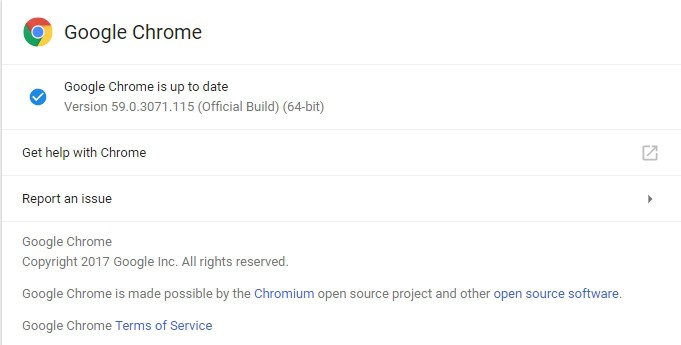
Google Chrome ranks #xiii on the CVE vulnerabilities list. The web browser is regularly updated. To install updates in Chrome, you can click on bill of fare button (iii horizontal dots on the correct side of the window) to cheque for updates. If in that location are new updates, the menu button dots will either be:
- Green, for 2-twenty-four hour period-erstwhile updates
- Orange , for 4-day onetime updates
- Red , for updates that are 7 days old or older
To install any updates, click on Update Google Chrome . If y'all do not see this option later clicking on the menu dots button, you lot are currently on the latest version.
Firefox security and software updates
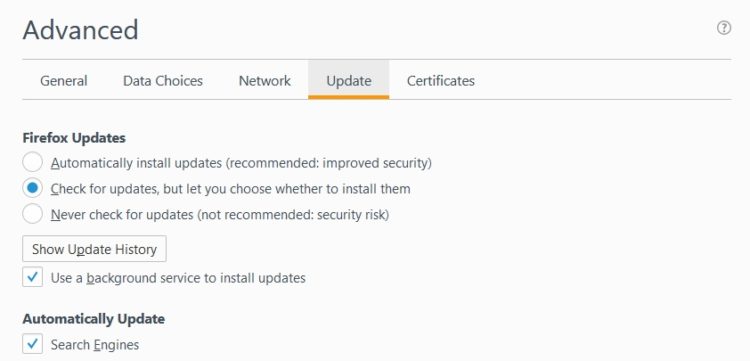
Firefox ranks at #21 on the CVE vulnerabilities list. You lot'll find that Firefox is set to automatically install security updates. However, y'all tin arrange these settings by doing the following:
- Click on the Menu (3 lines on the top correct) push
- Click on Options
- Click on Avant-garde
- Click on Update
- Select Automatically Install Updates if it is not already selected. If you lot practise not want automatic updates, select either Check for Updates, But Permit Y'all Cull Whether to Install Them or Never Cheque for Updates (non recommended)
OpenSUSE security and software updates

OpenSUSE users should ensure they are installing updates every bit they come, as this application is oft a target with many vulnerabilities. OpenSUSE ranks #6 on the CVE vulnerabilities list, making it one program users should update when those updates are available.
Click here to learn how to install updates for openSUSE, including how to employ the GNOME Update Applet and setup automatic updates for new software patches.
PHP security updates

PHP ranks at #30 on the CVE vulnerabilities list. This application is a common cistron for security threats but is non treated the aforementioned when information technology comes to security updates.
Click here to access the PHP website section on security to learn more than about PHP security.
Data backup remains the best defense
There's really no ii ways well-nigh it here. Cyber security defense methods are advancing, but and then too are the tools and methods cyber criminals are using to hack systems and steal or destroy data. With ransomware increasingly the most popular modus operandi for cyber criminal groups, both large businesses and individual users are increasingly likely to detect themselves on the receiving end of a nasty piece of malware. The potential for losing valuable data is increasingly more than just a serious business. Information technology'southward go a situation of "when" not "if."
Related: What is disaster recovery and how practice you plan for information technology?
Constructive data backup has become an essential tool to ensure continuity for businesses as well as to ensure regular consumers don't lose their valuable data and files. Both small businesses and average computer users, peculiarly, need to consider the necessity of these options too.
According to Small Business Trends, SMBs are a significant target for cyber criminals, accounting for 43% of all attacks against businesses. Additionally, SMB's should note the following, additional cyber security-related stats:
- As many equally 60% of small businesses are forced to shut within six months of an attack (a stat some have, understandably, questioned )
- 48% of attacks are due to malicious intent
- Only xiv% of SMBs are very confident in their power to mitigate security risks
Related: Every business can plan to preclude ransomware, here's how
Keep in heed that information technology wasn't simply SMBs that lost valuable data due to WannaCry and Petya. Many larger organizations, public service businesses, and individual consumers were heavily impacted, including of import services such as hospitals and utilities. Data loss is extremely expensive and, one time gone from your machine, information technology's often gone for good.
Information backup ensures that your data can survive fifty-fifty later on a ransomware assault or whatsoever other blazon of loss event. Whether it's a burn or a virus more malicious than Peyta, data fill-in helps ensure that your business can be back up and running.
A simple information rule of pollex: Any information not backed upwards is data y'all're willing to lose .
Read more: Data loss and disaster recovery statistics
Are security updates necessary?
The simple answer to this is "yeah!" Ii of the most recent and glaring examples we have of what can happen when users ignore security updates came with the WannaCry ransomware and the Petya virus attacks. The WannaCry ransomware attack, which ultimately infected over 400,000 machines and networks worldwide in the span of a few weeks, utilized a security flaw in the Microsoft Windows operating arrangement. The Windows exploit was originally taken advantage of by the National Security Bureau for their covert cyber warfare operations.
The Petya virus attack followed the WannaCry ransomware by about a month, utilized the aforementioned security flaw and stolen NSA tool, and infected even more computers forth the fashion. Perchance more disturbingly, the Peyta virus was non designed to grift coin from infected computers. Security researchers presently found that, whether purposeful or because of poor pattern, the virus functioned by completely wiping a computer's difficult drive . Despite enervating $300 in a style similar to ransomware, information technology was discovered that the Petya virus lacked the part to unlock files or to fifty-fifty receive ransom payments.
In fact, 1 West Virginia hospital had to chip all of their networked computers afterwards getting infected by the Petya virus. This was after the infirmary's administrators attempted to not simply recover files but as well attempted to pay the ransom, finding that reports on the virus were correct: there was no way to pay the ransom, even if they wanted to.
When the NSA had their hacking tool stolen so published online by a hacking group, the cyber criminals behind the WannaCry ransomware and those behind the Petya virus utilized the tool to their advantage. Other ransomware programs using the tool are also likely to crop up.
To be clear, Microsoft had already patched the vulnerability a calendar month before the WannaCry virus was released into the wild. That security update was freely available; many users simply chose to ignore it. Nevertheless, the difficulties in rolling out a such an update was also a potential headache for many large businesses and regime organizations, which may also exist why many chose to put off the update.
According to Kaspersky, the majority of the infected computers were running the outdated Microsoft Windows seven operating organisation, which is currently the nigh mutual version of Windows. Windows 8 and 10 computers were not vulnerable to the set on, while most Microsoft Server operating systems were also not heavily impacted.
Petya as targeted the same vulnerability, and therefore also impacted the same computers that were targeted past WannaCry.
The state of affairs revealed several reasons why security updates are necessary.
Security updates are more than of import for users of outdated software
If you have failed to upgrade a software programme to the latest bachelor version, you should be taking any security updates you can get. One of the key benefits to upgrading to a newer software version, be information technology an application or an operating system, is the fact that the developers spend a lot of time fixing security flaws that existed in the previous version(due south). The older the version y'all're using, the more security flaws that likely exist.
Additionally, while some express support volition be for older versions, the more versions behind you are from the newest version bachelor, the less likely it is that version you're using is still getting regular updates and security fixes.
Many users mistakenly assume that newer software versions are more vulnerable to security flaws. However, this is typically non the case. Newer software versions build on the previous version, fixing errors that existed in older versions. Developers also implement newer security tools into the newer versions of their programs and operating systems, making them less vulnerable to attacks. While older versions may still have programmer back up, older versions are oftentimes dropped, meaning any new flaws discovered may not become patched.
Additionally, there are times when software companies volition stop support for older versions every bit a style to subtly force users to upgrade to newer versions. The reason your older operating organization or software program may not be getting security patches is that the company wants you to upgrade. Dropping security support is a passive-aggressive manner to force users to adopt a new version. Yeah, that includes free software like Windows Internet Explorer . Software companies merely take so many resources and developers on staff to go on patching old programs.
While it is true that newer versions of software volition have as-withal-discovered vulnerabilities, it's of import to note that those vulnerabilities are often unknown to both the developers and hackers. Subsequently new software is released, in that location'south unremarkably a flurry of activity from security professionals and hackers to discover those flaws, making it somewhat of a race to run across who can find those exploits first. Once hackers discover and try to exploit those vulnerabilities, developers are oftentimes (but not ever) quick to patch those flaws.
The older a software version is, the longer hackers have had to analyze it, break downwards its code, and find its flaws. Especially if that software is pop or important for a specific manufacture, hackers can and frequently exercise discover vulnerabilities that they can exploit. Newer versions of the software will likely accept fixed those exploits, but older versions may withal have them, making the older software increasingly dangerous to have around.
Both popular and essential software are targeted by hackers more frequently
As The Verge reported, the majority of the WannaCry victims were running Windows seven. A key reason for this is because Windows 7 is still the most popular operating arrangement on the market. According to NetMarketShare , the Windows 7 OS makes up near 50% of all computer operating systems. As hackers are opportunists who tend to cast a broad net, finding vulnerabilities and creating viruses and malware for Windows 7 is more likely to reap some kind of advantage over other operating systems with a smaller marketplace share, such equally Linux. It certainly plays into their favor that businesses tend to lag when it comes to upgrading to newer operating system versions. For example, there are still more users on Windows XP (which is no longer supported) than on Windows 8, the Windows version that preceded the electric current Windows ten.
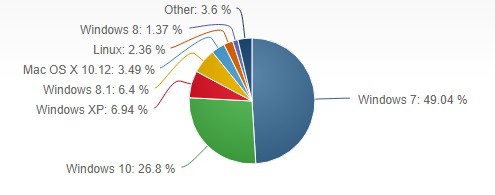
Withal, despite Windows 7 being the most popular and most normally targeted computer operating system, it'south far from the virtually vulnerable software program or operating organisation around. The heavily-cited website CVEdetails.com (Common Vulnerabilities and Exposures), found that Google's Android operating system had the most number of vulnerabilities in 2016 (unspecified version), while Adobe Flash Actor was the most vulnerable software programme. The site also shows that the "all-time" offenders announced to be Unix-based systems–Linux Kernel and Mac Bone X–while Google's Chrome and Mozilla's Firefox web browsers appear to be among the almost vulnerable of those types of programs.
Ignoring software updates tin can come with significant consequences
As is the case for those Windows seven users who chose to ignore Microsoft'southward security patch, failure to update software with such fixes tin outcome in the exact state of affairs the developers were hoping to prevent.
In 2016, security blog DarkReading published a post on The ten Worst Vulnerabilities of the Last 10 Years . That list includes the following:
- OpenSSL Heartbleed Bug : affected website SSL/TLS security, patched through software updates.
- DNS Cache Poisoning Flaw : affected spider web browsers, patched through software updates.
- GNU Fustigate Remote Code Execution Vulnerability (Shellshock) : affected web browsers and Linux systems, patched through software updates.
- Android Stagefright Vulnerability : affected Android operating systems, patched through software updates.
- SSL three.0 Protocol Vulnerability / POODLE Assail : affected website and web browser security, mitigated (just non completely patched) by disabling SSL iii.0.
- Remote Lawmaking Execution Vulnerability in Microsoft Server Service (Buffer Overflow Vulnerability) : affected Microsoft Server operating systems, patched through software updates. Read more than on buffer overflow attacks and remote code execution attacks.
- Java Serialization Bug : afflicted Coffee software and middleware products using Java, mitigated (but not completely patched) through software updates.
- Glibc getaddrinfo Stack-based Buffer Overflow : affected Linux distributions, patched through software updates.
- Bad USBs : not a software programme, but a known threat that's hard to mitigate.
In virtually all of these cases, those who chose to ignore the patches were at a high risk for malicious action on their machines. This was especially true for the Heartbleed bug which affected over 600,000 websites, allowing hackers to steal a significant amount of private encryption keys.
Here's a huge wrinkle in choosing to ignore a software security patch: they're almost always complimentary. So why practise users ignore them?
A 2016 enquiry paper in the Operations Research and the Direction Sciences (INFORMS) Journal notes that upwardly to 87% of computer users only ignore security warnings. The report suggests that users have substantially become desensitized to the warnings, as they're so used to messages popping upwardly for many dissimilar reasons, many of which are inconsequential. Additionally, as security warnings appear when users are in the middle of performing tasks, many make up one's mind to ignore them.
The problem, of course, is that anyone sitting at a computer is likely doing something of import or leisurely at the time a bulletin appears, and is unlikely to want to put a hold on that activity to install an update. The newspaper also provided a ranked list of what type of activities individuals may exist engaged in that leads them to ignore update messages and security warnings.
Topping the list of activities were "on the style to shut window" (74% disregarded), "while typing" (78% disregarded), "during video" (79% disregarded), and "while transferring information" (87% overlooked).
Regardless of why users do not update their security systems, simply put, they're ignoring the associated risks and choosing not to update.
If yous fall into that category, you're in good visitor. Nonetheless, the last visitor you want to be in is amongst the many people who have knowingly or unknowingly refused security updates and faced the distinct consequences for that action.
Source: https://www.comparitech.com/blog/information-security/how-to-install-security-updates/
0 Response to "What Type of Update Does Not Allow a User to Refuse or Delay Security Updates?"
Postar um comentário